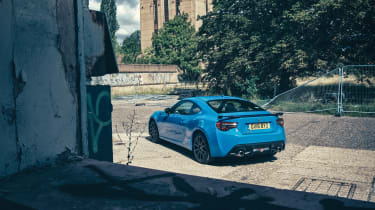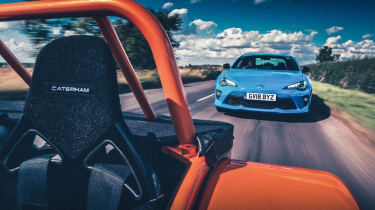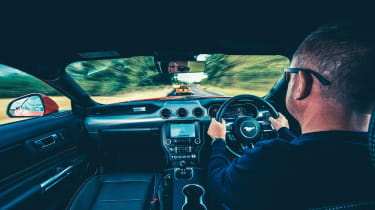Endangered species: Toyota GT86, Caterham Seven 310R and Ford Mustang driven
The naturally aspirated, manual gearbox performance car is a rare beast these days. Thankfully, a few hardy souls are still flying the flag
Funny how a rustle of leaves can deafen when there’s complete silence. Green foliage bursts from any and every exposed crevice, crack and gulley, frenzied in growth now that it’s completely unrestricted by human hands. Decay, rot, subsidence, erosion; slowly, but with a sense of crushing inevitability, nature is reclaiming what was once its own.
RAF Upwood’s days are most definitely numbered. New housing is well under the wire, encroaching on and then systematically consuming its core buildings that once stood neat and proud. This is ground that would have shaken to the roar of Rolls-Royce Merlins slung under the wings of De Havilland Mosquitos and Avro Lancasters, and latterly the thunder of its Avon jet engines on the groundbreaking English Electric Canberra bomber, but now there’s simply the distant rat-tat-tat of a heavy pneumatic drill, thumping into the ground to create foundations for three-bed semis.
> Gordon Murray Automotive T.50 test mule fires up on video for first time
Yet the longer I stand amongst this post-apocalyptic landscape, the more I’m aware of another presence. A loose, deep, sinister thud of an idling V8; a low, dazzlingly blue nose protruding past a smashed-in shutter door; the glint of an antiquated headlamp shining in the dark of a fire-ravaged room, like a single, shy eye out on a stalk. Remember that scene in the original Toy Story movie where Woody and Buzz inadvertently find themselves stuck in the bedroom of the psycho lad who lives next door? Aghast, they’re surrounded by the Frankenstein toys the boy has created by mashing together heads, torsos, tracked vehicles and so on, slowly creeping out from under his bed. Here too, gingerly, the Ford Mustang GT, Toyota GT86 and Caterham 310R roll slowly into the open, but just as our animated heroes discovered, there’s nothing to be afraid of. They’re freaks – with naturally aspirated engines and manual gearboxes – but they’re to be celebrated, not feared. They’re the survivors. For now.
We’re here because of a chance conversation in the evo office. It started with the Stang, as plenty of chats do at present, and probably emerged from another overwrought monologue from yours truly about the simple but heartfelt appeal of rumbling around in the big ol’ Fast Fleet pony car, letting it pull from barely 1000 revolutions per minute and driving everywhere with the windows down, Dukes of Hazzard style, just to enjoy that Detroit bassline. It feels so good partly because, it dawned on me, it was a rare, almost illicit thrill. This in turn got us thinking about which other new performance cars still offer a similar combination, namely an engine breathing at atmospheric pressure, and three pedals and a stick.
Would you believe the answer is around seven? No, none of us could either. Apologies if we’ve missed something obvious, but I make it the aforementioned Ford and Toyota (and its twin, the Subaru BRZ), some of the cars from the Caterham stable, Mazda’s MX-5, Nissan’s 370Z (yes, you can still buy one) and the new Porsche 718 Cayman GT4 and Boxster Spyder. You can argue about whether certain cars are derivatives or independent in their own right, but whichever way you slice the pie created by the traditional sporting car recipe, it’s a very small number, and one easily low enough to put them on the endangered species list.
This is a trend that began in earnest at the turn of the millennium, and as such, it’s nothing new. And yet it does feel like the endgame has crept up on us all, an accelerated demise of something we at evo, and I’m sure many of you too, hold so dear. Why this should be the case inevitably leads us to a dissection of evoness at a cerebral level. It is the sort of discussion often to be heard in a good pub frequented by driving enthusiasts – or just as likely in the paddock at a trackday – and its sliding scale of viewpoints is entirely analogue, never binary. There is no right or wrong answer, for we all gain our unique motoring fix via a different concoction of sensations, experiences and emotions, the mix subject to various weightings for the key elements depending on the individual. But at its core is the separation of speed and driver involvement, of whether the thrill is in reaching the destination quicker than ever, or in the work you have to do to reach that point, albeit seconds – or whole minutes – later.
Undeniably, there are many factors at work here – a perfect storm that has made what many would classify as the purest form of driver’s car almost extinct. We’ve all heard the emissions and fuel consumption argument, and I think we all understand that the law is, inevitably, an ass. A ‘downsized’ and therefore inevitably turbocharged power plant may well respond more frugally in a laboratory test, particularly under the previous NEDC regime, and an auto ’box may well be a free pass on the rollers, but in the real world most of this stuff is nonsense. You only need to drive something such as a Porsche 718 to realise this: its fuel consumption is often worse in reality than its naturally aspirated forebear, and don’t even get us started on the other attributes lost in the switch. We’re not saying turbocharged engines and automatic transmissions don’t have their place – of course they do – but a more sensible solution is surely to select the best engine and transmission for the weight and remit of the car, rather than a legislative straitjacket approach.
For me it comes down to this: if you want the best car, if you want the quickest car, if you want the fastest car around a circuit or on a drag strip or wherever, then the thrust of this story is entirely academic. But if you view the very task of driving as entertainment in itself, something to be learnt and hopefully mastered, and these days, more than ever before, an activity that’s a hobby, then there’s still no substitute for a manual transmission, and more often than not, one combined with a naturally aspirated engine.
Let’s start with a perfect case in point. There is no more reason required to buy a Mustang than its 5-litre ‘Coyote’ V8. Yes, it’s a decent, loveable car (could even be an excellent one with a little aftermarket fettling), but it’s really all about that motor, which is why it’s all the more reassuring that 70 per cent of sales in the UK are for the bent eight, not the rather insipid four-cylinder turbo. Nevertheless, it’s still all too easy to sour the milk by specifying the ten-speed automatic ’box, a transmission that never quite knows which ratio to be in and when, that blunts the response of the throttle and that refuses to let the V8 deploy one of its most appealing assets, namely the ability to deliver a linear shove from virtually walking pace to well over the ton, and all in third gear.
To be fair, the readily believable claim that the GT is bursting apart with torque is actually some way from the truth, because this four-valve-per-cylinder, DOHC lump revs to over 7000rpm and gives by far its best punch in the last 2500rpm of its reach. And that’s not to mention the yawningly long gear ratios that take the edge off its ultimate sprinting ability (but which do mean it’s a 30mpg car on a cruise). But whatever it’s doing, it’s the industrial, gruff noise that always captivates, whatever the journey and whatever the speed; there are times when you can almost feel and hear each individual piston stroke and combustion explosion. Yes, there are also turbocharged V8s that sound (artificially) good, but frankly, not many.
More of a surprise is the Mustang’s gearchange, thanks to the fitment on this car of a Ford Performance short-shift kit. While you might find incredulous the fact its directness out-Caterhams the Caterham, it’s true – it does. There’s more effort required – even compromise, given the increased muscle power needed, the vibration and the assorted sounds now passed along the linkage – but if you love the actual physicality and interaction of driving, that’s all surely repaid many times over. Combine engine and ’box in this state of tune and for me at least, even a run for bread and milk makes you feel like Parnelli Jones in a Bud Moore Boss 302. If it were mine, I’d fit window nets…
Ford Mustang 5.0 V8 GT
| Engine | V8, 4951cc |
| Power | 444bhp @ 7000rpm |
| Torque | 390lb ft @ 4600rpm |
| Weight | 1668kg |
| Power-to-weight | 270bhp/ton |
| 0-62mph | 4.6sec |
| Top speed | 155mph (limited) |
| Basic price | £42,810 |
The GT86 has suffered from the ‘it’s not fast enough’ curse since its inception in 2012. Overhyped (sound familiar, Toyota?), and hailed as the ultimate back-to-basics, affordable sports coupe, it’s been neither affordable enough nor, frankly, quite good enough over the intervening seven years to make us re-evaluate our initial reservations. Was it us though, not Toyota, that got it wrong; fattened on lazy torque like motoring foie gras, impatient motorists weaned on the instant punch of the contemporary turbodiesel engine?
Nah. For me, the Subaru flat-four’s vocal, coarse note above 4000rpm (where you must spend all your time if you’re to make any meaningful progress) and the misguided decision to fit Michelin Primacy tyres best suited to a Prius (and which provide some fairly nasty characteristics in terms of breakaway, braking ability and wet weather manners) must shoulder the majority of the blame.
Yet the advancing years see me increasingly warming to the GT86, and I think that has plenty to do with the root of this story. I’ve learnt to tolerate its uncouth underbonnet exertions because they’re worth it for an engine that gives more back to the driver the more effort you put in. I like to feel the crispness of its response on an intermediary blip between gears, and I no longer care in a post twin-turbo/dual-clutch/700bhp-is-barely-enough motoring world we now live in that the little Toyota’s engine has to be revved until its valves are hysterically bouncing to really get the car moving with conviction. On the contrary, I love it, for there’s a very real pleasure from driving a car hard while not contravening the law and ruffling social conventions – it’s a rare sense of freedom, denied to those always nervously glancing at the speedo and constantly checking their pace. Here, then, is the opposite of the Mustang’s take on this combination: the GT86 gives little at low effort, but encourages and rewards when you up your own game.
And intrinsic in that appeal is the fine six-speed manual gearbox. A regular automatic would be awful – the outdated six-speed one offered is almost as unappealing as having the five-speed slusher in an original NSX for a car like this – and yes, a decent twin-clutch option would not only reduce time lost manually swapping cogs but also make it far easier to keep that peaky engine on the boil at all times. But there’s a problem. With only two pedals to work and little to preoccupy the mind other than flexing a few fingers at the right moment, the flat-four’s slog up the rev range would inevitably become more frustrating. Take a task away from the brain and its focus intensifies on those remaining to it. It’s the same reason why driving a car such as the Tesla Model 3 Performance is a new challenge with its own rewards, and why 20 years ago, despite manufacturers earnestly assuring us that the early single-clutch automated manuals, such as Ferrari’s original F1 ’box and the first-generation BMW SMG, could change as quickly as the average human, they felt so horrendously lethargic. With the brain unoccupied in those vital milliseconds that are normally consumed by timing foot, pedal, hand and lever so precisely, it all gets… well, a little predictable and boring.
Toyota GT86 Blue Edition
| Engine | Flat-four, 1998cc |
| Power | 197bhp @ 7000rpm |
| Torque | 151lb ft @ 6400-6600rpm |
| Weight | 1240kg |
| Power-to-weight | 161bhp/ton |
| 0-62mph | 7.6sec |
| Top speed | 140mph |
| Basic price | £29,020 |
But to take us to the core of this argument it had to be a Caterham, didn’t it? The future certainly has its challenges for the small firm that carries the torch for Chapman’s original genius (see evo 265), but in the Seven remains arguably driving in its purest form, and to deviate away from the combination celebrated in this story is almost unthinkable. Sure, the 620R is supercharged – mechanical forced induction has never been such a dark devil as turbocharging in any case – but no one really needs to go that quickly in a Caterham, especially so on the road, and the appeal of the entry-level 160 model, with its tiny turbocharged triple, has always been eroded by the boosty, less immediate character of having a blown power plant. No, if you want maximum Caterham, you need a sharp-fanged naturally aspirated four-pot and five or six ratios slotting home with the precision of a Lee-Enfield.
This orange 310R is an excellent reminder of that fact, just as getting back into a Caterham after a number of months away is always a startling reality check of how heavy, over-complicated and obsessively desensitised most modern performance cars have become. Even breathing inside a Seven seems to alter the trajectory of the car, its pitch or its yaw.
Fundamentally, every kilo matters in a very light car such as this, which is why the thought of intercoolers, turbine housings and a second clutch jars so profoundly with the overall concept. But it’s that aforementioned immediacy that’s the key point: when you’re in a car where you feel everything, right down to a twig or pebble left in the road, where such minor adjustments to every major control have a direct effect, to not have an engine with the same eagerness, or to surrender the delicious connection with the drivetrain a manual ’box provides, would be to neuter the Seven’s vibrancy in a way that’s almost unthinkable.
Thankfully, that’s not the case today, and instead the 310 parps and coughs from the side-exit exhaust that exhales somewhere below my right elbow, batters my head with a gale like sitting in an F1 wind tunnel, and remains as relevant and refreshing today as it ever has.
Caterham Seven 310R
| Engine | In-line 4-cyl, 1596cc |
| Power | 152bhp @ 7000rpm |
| Torque | 124lb ft @ 5600rpm |
| Weight | (dry) 540kg |
| Power-to-weight | (dry) 286bhp/ton |
| 0-60mph | 4.9sec |
| Top speed | 127mph (claimed) |
| Basic price | £32,385 |
The extermination, then extinction even, of this combination has already happened in other categories found in the evo Knowledge. Notice how there are no hot hatches in our trio? You might think that the cheaper, arguably simpler end of the performance car market would be more resilient to the encroachment of new technology, but being based on the mainstream has accelerated the process, and the rise in kerb weights across the board has also played its part: the heavier the car, the more torque required to get it moving with the required zest, and turbochargers can always be relied on for that. The only defence of the NA engine would be to raise displacement, a tactic with the potential to fall foul of the emissions and consumption matrix, which has long since seen off cars such as the Volkswagen Golf R32.
The previous Swift Sport was perhaps the last of the superminis to conform, but in the bigger hatch class it’s been a long time since it was enough to have a decent twin-cam 16-valve motor. The last great exponent was probably the Peugeot 306 GTi 6/Rallye, an old car by the year 2000. The 2002 Ford Focus RS Mk1 then changed everything, putting 200bhp-plus of turbo power through the front wheels, and by 2007 only the FN2 Honda Civic Type R stuck with the NA and manual combination – albeit rather unsuccessfully. Today, some manufacturers cling to the manual ’box, such as Renault Sport, Honda and Hyundai N, but they’re hooked up to turbocharged engines with power outputs that would once have looked good in a supersaloon.
Talking of heavy metal, only Lexus continues to offer big, naturally aspirated V8s, but with a torque converter ’box. The last great manual NA supersaloon? That’s surely the E39 BMW M5, now a genuine classic. Less of a surprise is the disappearance of manual gearboxes in the supercar and hypercar arena. Ferrari set the trend, being a staunch supporter of the single-clutch automated manual and developing it to the point where, for fast driving at least, it was actually quite good. It too has since switched to the ubiquitous twin-clutch ’box, as have Lamborghini (partly) and Audi, and Honda with its new-age NSX. Both Ferrari and Lamborghini cling to big naturally aspirated V12s at the top of their ranges (though the latter is readying a hybridised V12 – see p38), because they know it’s a point of difference demanded by their wealthy clientele. But you have to go back to the 599 and Murciélago LP670-4 SV for those stunning V12s to be combined with the scrape and snap of an open-gate manual shift. Others, such as McLarens, have been turbocharged and twin-clutch from the very beginning, and in a way that’s not necessarily a bad thing, because so violent is the modern supercar in performance that there are cars – yes you, the 720S – that it’s hard to imagine being usable with a manual gearbox, particularly one that can contain the volcanic turbocharged torque from low revs that’s on offer.
So far, only Porsche has been brave enough to be suitably reactive to those clamouring for the magic combination. It courted controversy by offering the first of the modern-era GT3s (the 991.1) in PDK-only form, a mistake it didn’t make with the second-generation car, which was offered with both manual and PDK. Increasingly there’s a split where the cars Weissach makes for ultimate circuit pace – think GT3 RS – have PDK ’boxes, while those aimed at more emotive on-road thrills – such as the 991 Speedster and GT3 Touring – get manuals, or at least the choice of both, as with the regular GT3. Obviously, the aforementioned GT department 911s use the wonderful naturally aspirated flat-six with its 9000rpm rev limit, and again it would be difficult to convince this specific customer base on the merits of a downsized turbo equivalent.
Even more important though, is the emergence of the brilliant new 718 Cayman GT4. The previous 981 version stole all our hearts back in 2015 when it scooped eCoty from under the noses of its GT3 RS bigger brother, not to mention the McLaren 675LT and the Ferrari 488 GTB. And that GT4’s simple recipe of tuneful NA flat-six and rewarding six-speed manual were the perfect antidote for our times. Perhaps buoyed by its success, Porsche has taken the unprecedented step of developing an all-new naturally aspirated engine for its 718 successor, precisely to fill that niche where driving enthusiasts really desire the purity of a high-revving and responsive engine. That the car has been launched with only a manual option is surely no coincidence either…
Back at RAF Upwood, the sound of approaching traffic – turbodiesel and auto, naturally – alerts our trio, and it’s time to scarper smartish, to vanish back into obscurity, although not before the Mustang has left its own version of a Banksy protest: two sticky black patches of burnt rubber like bear paws and a cloud of tyre smoke so dense the big red coupe vanishes inside a bluey-white cloak of swirling vaporised rubber. Perhaps their days are numbered, but there is, of course, one Last Interceptor, one last hero on the barren road fighting the good fight, one last defender of the faith. An extraordinary car designed by a genius with a big moustache and a nice line in colourful shirts. The GMA T.50 may well be the last of its kind, but it’s set to be one hell of a way for the naturally aspirated engine and manual ’box combo to go down fighting.











